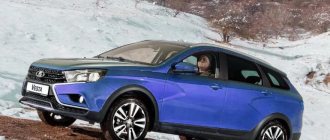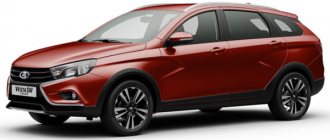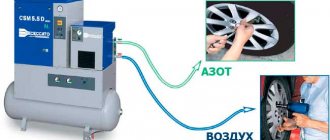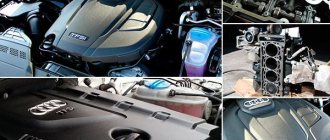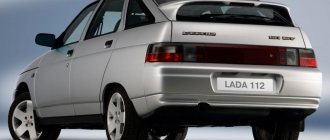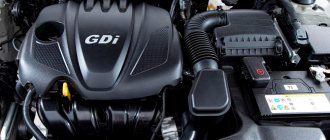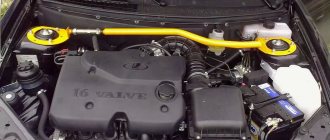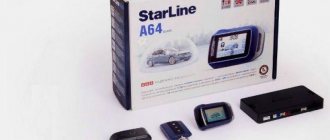A modern car must meet certain requirements for safety, convenience, handling, comfort, and maneuverability. AvtoVAZ developers tried to implement all this in their brainchild Lada Vesta. They created a fundamentally new design - the front suspension of the Lada Vesta is not modernized from previous versions, but a completely new invention.
In the production of its latest models, the manufacturer for the first time in many years abandoned old ideas and brought new developments into reality.
Lada Vesta station wagon
The Lada Vesta SV station wagon is a long-awaited event that fans of the domestic automobile industry have been eagerly awaiting. The manufacturer offers the model in several configurations, giving the consumer the right to choose based on personal needs. At the same time, AvtoVAZ presented to the public two station wagon models at once. In the car line they are listed as Vesta SV and Vesta Cross.
The vehicle is an original development of the manufacturer and is very different from previous versions. Technical characteristics provide the car with an excellent combination of handling, comfort and cross-country ability. The domestic station wagon is of considerable interest among car enthusiasts. And one of the reasons for this phenomenon is the front suspension of the car.
Equipment
For the SV Cross the Luxe package is offered, for the SV - Lux and Comfort. Depending on the configuration, machines can be equipped with the following functions and systems:
- Electronic stability control with traction control option. This helps when starting on a hill.
- Front and front airbags (four in total).
- Three-stage heating of the front and rear seats.
- The driver's seat is height adjustable and has lumbar support.
- Heated windshield and windshield.
- Exterior mirrors are electrically heated and electrically adjustable.
- Automatic climate control system.
- Parktronic.
- Multifunction steering wheel.
- Cruise control system.
- Cooled glove box.
- Audio system.
- Rear armrest.
- Rear View Camera.
- Fog lights.
- Second floor panel.
- Luggage compartment organizer.
- Light and rain sensor.
In addition to the basic package, there are additional packages such as Multimedia, Prestige, Image.
Lada Vesta suspension - design and distinctive properties
The domestically produced car was tuned at the Spanish IDIADA test site. The manufacturer has set itself the task of achieving ideal interaction between the car and the driver. As a result:
- Transport moves confidently in a straight line. When driving, you can feel the zero steering control very well.
- The car does not shake when cornering, as well as during braking and acceleration.
- While driving in any situation, good communication between the driver and the car is maintained.
The suspension of the Lada Vesta SV has built-in electronic assistants - ABS, EBD, ESP systems. Built-in stabilization makes movement easier and provides complete control over traction. The car is characterized by excellent cross-country ability, which is largely ensured by electronics and proper tuning of the car’s suspension. Simulated differential locking allows you to overcome off-road conditions. The company received a lot of positive feedback for this innovation.
In the city of Sochi - very fast
The combination of a 122-horsepower engine and a manual transmission is fire! There is always enough engine, although there are three passengers in the car besides me and some luggage. The gears successfully cling to each other - there are no problems either on the highway sections or in the plugged uphills at the exit from Sochi towards Solokhaul, where there is always a lot of traffic. The clutch does not require filigree footwork: you just release the pedal and go. Only occasionally did a slight itch irritate me, but this, as the engineers assured me, was a consequence of the fact that the engine calibration had not yet been completed.
Vesta front suspension
The front suspension is a completely original design that was developed from scratch. It is based on double-sided shock-absorbing struts filled with gas, on which coil springs, a stabilizer and lower arms are located.
Lada Vesta suspension device
The design uses a universal L-shaped lever, which replaced the longitudinal extension from previous versions. It copes well with various loads due to the use of a castor of 5 degrees. An eye-catching part of the suspension is a subframe with two support points for stretching.
Vesta rear suspension
The rear suspension uses a redesigned design from the Renault Zoo electric car. The model differs from its predecessor in the length of the beam. Also, the suspension is equipped with trailing arms, and domestic struts of Skopin origin are used.
The rear suspension makes driving even more comfortable and safe due to the location of the shock absorbers in the arches. The springs are located under the side members, which increases comfort during movement.
Comparison of the suspension of the Lada Vesta SV sedan and station wagon
It so happened that for many years the weak link of VAZ cars was the chassis. In his new product, the manufacturer offered a revised and improved version of its predecessors. The bulk of the changes were made to the front suspension. Many new parts have appeared, such as a subframe to increase body strength, L-shaped levers made of high-quality steel.
Suspension of Lada Vesta sedan
The rear suspension designs are almost identical. The suspension of the Vesta station wagon has modified springs and shock absorbers, which increases the strength properties and allows it to withstand increased loads. The rear springs in the SW model are 9 mm larger.
Exterior and safety
The practical station wagon body was immediately appreciated by many families, and the increased ground clearance became an excellent option for Russian roads. The ground clearance is 203 mm , which is a good indicator for lovers of country trips.
Overall dimensions are (LxWxH) 4424 x 1785 x 1526 . Weight 1230–1300 kg . Despite the fact that large dimensions and weight create greater difficulty in driving, they make the car safer.
When passing the crash test, the station wagon was awarded 4.9 points out of 16 possible , which is undoubtedly an excellent result.
Safety is ensured by two airbags and seat belts with pyrotechnic tension and force limiters.
The exterior of Vesta SW Cross stands out among other cars, including due to its varied color palette. There are 10 colors in total, and, as is usual at the factory, each has its own name. The Mars color was released exclusively for the station wagon. Other names include: Carnelian, Glacier, Angkor, Carthage, Blues, Phantom, Pluto, Black Pearl and Platinum.
Differences between the suspension of Lada Vesta SW and Lada Vesta SV Cross
The version with the Cross prefix differs not only in its external qualities, but also in its technical properties. Externally, the model looks strong and brutal. But driving performance does not always correspond to appearance. To justify the name of the model, the manufacturer decided to change some structural suspension components, but did not conduct experiments with the engine.
Front suspension of Lada Vesta Cross
The Vesta Cross suspension has slightly different shock absorbers. Here they are more rigid, although they belong to the same type. The sports version has longer and stiffer springs. The developers also made some manipulations with certain settings. Changes in parameters have increased the sharpness of response to steering wheel control, and its position is more clearly felt. During speed, after a maneuver, the car quickly returns to its previous control positions.
Lada Vesta is a great achievement of the domestic manufacturer. Due to structural changes, the vehicle received higher handling and safety characteristics. This was achieved through the use of various innovations.
First test of Lada Vesta SW and SW Cross. Vesta Ver.2.0: universal and improved
They say they wait three years for what was promised. We waited only two times for the station wagon: exactly that much has passed since the premiere of the bright orange concept in Moscow, which took place even before the start of sales of sedans. Then they promised us: expect a station wagon next fall. And they even hinted that the appearance of an all-wheel drive version is possible. Alas, the station wagon was not ready in the fall of 2016, and VAZ today is trying not to talk about all-wheel drive at all, as well as the prospects for a version with an automatic transmission...
A regular SW station wagon cannot be distinguished from a sedan from the front. The SW Cross version looks original due to the modified front bumper. And it's not just the black protective plastic overlay, which, according to chief designer Steve Mattin, "emphasizes the X-face."
In the meantime, Steve Mattin is giving us another lecture about the new Lada design style, about its genetic “X-code” and about the details and touches with which this very code is manifested and emphasized. But the most important information for the client is that the rear lights and bumper of a regular station wagon are unified with those of a sedan in order to reduce costs.
Few people notice that it is drawn not only on the front, but also on the back. The characteristic shape can be seen in the lines of the stamped lamps on the bumper. On the SW Cross version this is even more noticeable
Only the SW Cross version has its own bumpers. And even then, mostly due to the “off-road” plastic decor.
With all the desire of the VAZ team to reduce production costs, you can admire the appearance of the new station wagons. Without exaggeration, it is worth saying that these are some of the most beautiful and harmonious “sheds”. However, what kind of “sheds”? The letters SW mean nothing more than Sport Wagon - this is how their creators position these cars. This concept was chosen not only for the sake of creating “beauty”, but also to attract a younger and more active audience, which precisely requires not only practicality, but also an emotional appearance. Yes, in the parking lot of the Sochi airport, the line of Vests with a universal body did not attract much attention - there was no way to recognize the new product from the front. But at the rear... That's where the idea of a "floating roof" and a "shark fin" C-pillar came in handy. Barn? Come on! Even the SW Cross, which looks more brutal and impressive due to its protective body kit and larger 17-inch wheels, is perceived as a gracefully dynamic car.
Fundamentally the interior remains the same. The regular SW station wagon has no differences from sedans at all. The cross version is distinguished by inserts on the panel and seats - in classic silver-gray (pictured) or in brighter and more emotional orange tones. The dashboard is now installed on all Vestas in the so-called “Euro version” - with orange scales. The rear view camera now has dynamic trajectory markings
But SW buyers will receive not only appearance and spaciousness, but also a whole “package” of improvements. Rear disc brakes are now installed on all versions of the Cross and station wagons with a 1.8-liter engine. Didn't the sedan have rear lights? Get an extra light in the ceiling. Was the heated windshield turned on only with the rear window and mirrors? Here's a separate key on the console. Did you complain that the electrically heated front seats were either too hot or turned off? Now it has as many as three stages that turn on sequentially, and the power keys themselves have become clearer and easier to press. In addition, warm pleasure has become available for rear passengers, as well as a folding armrest, a 12-volt socket and a USB port! Instead of a stunted misunderstanding dangling at the end of the back of the driver's seat, there is now a real storage box, the glove compartment has a special organizer lid, and the fuel tank flap is locked with a central lock.
The unsuccessful parody that was still offered for luxury sedans has been replaced by a normal armrest with a box. Electric heating in the front has become three-stage, and the glove compartment now has a microlift, a partition organizer, holders for business cards and even a cup holderThe rear seat itself remains the same, but the headroom has increased by 2.5 cm. Comfort for riders has been increased due to an armrest, electric heating, an additional lampshade and, of course, the ability to recharge their gadgets either from a 12-volt outlet or via a USB connector
Vesta SW is associated with a luxury passenger car. And the abbreviations are the same: remember, there used to be “SV” - sleeping cars? The new station wagon is quite suitable for this role.
But, of course, the main features of station wagons are hidden in the trunks. Looking at the numerous improvements and amenities, I am inclined to suspect that the AvtoVAZ employees in charge of the cargo compartment were trained at IKEA stores. There are not only hooks for bags and two lamp shades, but also a removable roll-up curtain, a 12-volt socket and even a pocket with a shelf where it’s easy to place a bottle of anti-freeze, a can of oil or some other small thing that any normal car owner needs .
In the trunk you can find not just a “sandwich” - a whole “hamburger”! A double false floor, under which lies a double foam organizer, another false floor is hidden under it, and even lower is a full-size (!) spare tire with a built-in organizer. Great! — until he feels the urge to take out the fifth wheel when the cargo compartment is full...
The official trunk volume figures are exactly the same as those of the sedan - 480 liters. But the whole point is how well the cargo space is organized.
The test featured station wagons only with manual transmission with top-end 1.8-liter 122-horsepower engines, for which steep mountain road climbs should not be a problem! Or…? With such volume and power, you would expect easier acceleration. But Vesta SW picks up speed with restraint, with a sense of self-esteem. To confidently storm serpentines, it is necessary that the tachometer needle does not fall below 3000 rpm. I am glad that the background noise, even in such modes, remains at an acceptable level.
The 1.8-liter engine is created on the basis of the 1.6-liter by increasing the piston stroke. The engine was not as torquey as its basic version, but with more thrust, which is more important for a station wagon. 5-speed manual transmission - developed by Renault (the same was installed on the first Vesta with a 1.6-liter engine)The driver “feels” the “backpack” of the trunk that appears behind him only with his eyes, looking in the rear-view mirrors. On the serpentines from Krasnaya Polyana to the Sochi Olympic Village, the new Vesta SW drives exactly like a sedan: correctly and even at times recklessly. But what’s even more surprising is that the “off-road” version of the universal Vesta with the Cross nameplate also feels good in corners.
On a highway full of turns, the weak return action of the steering must be compensated ... by the driver's hands. This way, return the steering wheel to zero faster than it would happen naturally. If you get used to this, you will be able to appreciate the capabilities of the chassis, which Vesta has very high
Unfortunately, the shortcomings of the steering inherent in sedans have not gone away: the steering wheel still does not fully inform the driver about the position of the front wheels and is also in no hurry to return to zero at the exit of a turn.
If only the rear suspension of a regular station wagon underwent modifications, then to modify the Cross it was necessary to change the front shock absorbers with springs: after all, on the “cross” version the ground clearance was also increased by 25 mm (from 178 to 203 mm). Another nuance that also affects driving performance is the larger 17-inch wheels with low-profile Pirelli tires. In theory, on such “skating rinks” the Cross should have become tougher. In addition, there is a recent example of the raised Kalina and Largus, in which the increase in ground clearance reduced the rebound travel of the suspension, which did not have a very good effect on comfort (especially in the case of Kalina Cross). What to expect from elated Vesta?
Vesta SW Cross turned out to be even better than conventional station wagons and sedans in terms of chassis tuning. The driving experience in the elevated station wagon was a pleasant surprise. In addition, energy efficiency has improved
Surprisingly, the Cross's suspension seems denser and more monolithic! Grippy tires with a lower profile height “break” less, they don’t “lead” as much in sharp turns, and they filter out most road defects even better than the wheels on simple Vestas. The rolls, despite the increased height and center of gravity, no longer began. The only thing in which the raised station wagon is inferior to the usual one is in overcoming deep holes or sharp asphalt joints at speed: impacts occur a little earlier.
Rear disc brakes are, of course, good. Their appearance will please many, but by and large you won’t notice any difference in the quality of deceleration under normal conditions
“Are you sure you upgraded the front stabilizer struts?” The VAZ workers were categorical: “We changed the material of the liners and now the hinges are reliable and durable.” I want to believe…
A separate point in the test program for the SW Cross version was driving on dirt roads. Here you need a clear understanding that an off-road body kit and even increased ground clearance will not turn a front-wheel drive station wagon into a “mud-mover”. On one of the “off-road” sections, the rolled-out passage was blocked by a broken-down Niva, and without a shadow of a doubt I directed the car onto the side of the road washed out by the rain. Yes, in this case the orange Cross broke through thanks to the help of the traction control system. But diagonal hanging showed that Vesta’s electronics are not able to simulate inter-wheel locking - which is what really helps front-wheel drive cars in difficult conditions.
The increase in ground clearance did not affect the suspension travel. But still, when moving under tension, the front wheels begin to slip even before the rear wheels come off. Therefore, it is better to overcome steep terrain bends on Vesta Cross on foot.
Oddly enough, the most important impression from the West station wagon test was not the very appearance of new modifications of the successful model. And not even a thorough study of the luggage compartment, which does not often happen on models of this level. What pleased me most was that AvtoVAZ listened to the criticism and wishes of its customers and carried out a whole range of work to improve the car. Moreover, a considerable part of these improvements are available not only for expensive versions, but also in basic versions. Probably the only serious drawback is the prices: Vesta SW will cost at least 639,900 rubles, and SW Cross cannot be bought for less than 755,900 rubles. But similarly equipped classmates will still be more expensive, and, most importantly, they will not be able to offer a station wagon. Therefore, despite the fact that instead of the once promised all-wheel drive, Vesta only has an increased ground clearance, and instead of an “automatic” there is still a “robot”, I would confidently recommend any of these cars as the most versatile option for a new car in the B+ segment.
Technical characteristics of Lada Vesta SW and SW Cross (manufacturer data)
| Lada Vesta SW | Lada Vesta SW Cross | |||
| Body | ||||
| Type | Station wagon | |||
| Number of seats/doors | 5/5 | |||
| Engine | ||||
| Type | Petrol | |||
| Engine location | Front, transverse | |||
| Number and arrangement of cylinders | 4, in a row | |||
| Working volume, cubic meters cm | 1596 | 1774 | 1596 | 1774 |
| Power, hp at rpm | 106/5800 | 122/5900 | 106/5800 | 122/5900 |
| Torque, Nm at rpm | 148/4200 | 170/3700 | 148/4200 | 170/3700 |
| Transmission | ||||
| Drive unit | Front | |||
| Transmission | 5-speed manual transmission (5-AMT) | 5-speed manual transmission (5-AMT) | 5-speed manual transmission | 5-speed manual transmission (5-AMT) |
| Brakes | ||||
| Front | Ventilated disc | |||
| Rear | Drums | Disk | ||
| Suspension | ||||
| Front | Independent, spring, McPherson | |||
| Rear | Semi-dependent, spring | |||
| Dimensions, volume, weight | ||||
| Length/width/height, mm | 4410/1764/1512 | 4424/1785/1532 | ||
| Wheelbase, mm | 2635 | |||
| Ground clearance, mm | 178 | 203 | ||
| Curb weight, kg | 1280–1330 | 1300–1350 | ||
| Fuel tank volume, l | 55 | |||
| Trunk volume, l | 480–825 | |||
| Tires | 195/55 R16, 185/65 R15 | 205/50 R17 | ||
| Dynamic characteristics | ||||
| Maximum speed, km/h | 174 | 180 (182) | 172 | 180 (181) |
| Acceleration to 100 km/h, sec. | 12,4 (14,4) | 10,9 (12,9) | 12,6 | 11,2 (13,3) |
| Fuel consumption, l/100 km | ||||
| Combined cycle | 7,3 (7,0) | 7,8 (7,6) | 7,5 | 7,9 (7,7) |
| CO2 emissions, g/km, eq. Class | n.d., Euro-5 | |||
| Cost of the car, rub. | ||||
| Basic equipment | 639 900 (664 900) | 697 900 (722 900) | 755 900 | 780 900 (805 900) |
There is no special underbody protection, other than the factory metal crankcase protection, for station wagons. The only visual difference is the bifurcated muffler pipes for the Cross version and a slightly higher body position
| Equipped with security systems | ||
| Lada Vesta SW | Lada Vesta SW Cross | |
| Front airbags (driver/passenger) | + | + |
| Side airbags | O | + |
| Curtain airbags | – | – |
| Driver/passenger knee airbag | – | – |
| Inflatable seat belts for rear passengers | – | – |
| ESP stabilization system | + | + |
| Traction control system TCS | + | + |
| Anti-lock braking system ABS | + | + |
| Brake Assist | + | + |
| Rear View Camera | O | O |
| Parktronic | + | + |
| Parking assistance system | – | – |
| LED headlights | – | – |
| Xenon headlights | – | – |
| Adaptive headlights | – | – |
| Lane Change Assistance System | – | – |
| Marking tracking system | – | – |
| Forward Collision Avoidance System | – | – |
| Traffic Sign Recognition System | – | – |
| Driver fatigue monitoring system | – | – |
| Turning on the hazard warning lights during emergency braking | + | + |
Competitors
The uniqueness of the situation is that there are no direct competitors to the new station wagons on the Russian market. All companies that offered or could offer something similar either stopped selling the corresponding models (for example, Skoda Fabia) or relied on crossovers (Hyundai Creta). Therefore, we will indicate only indirect competitors that are similar in size, cost and cargo transportation capabilities.
Lada Largus
Based on the Renault B0 platform, Largus is essentially nothing more than a slightly modified Dacia Logan MCV station wagon by VAZ. The body and comfort of this model were outdated already at the beginning of production - in 2012 (in fact, Logan was already 8 years old by that time - most models by this age change a generation, and sometimes two). Nevertheless, Largus remains a unique offer on the market not only due to its capacity (there are versions with three rows of seats), but also due to its relatively low cost: from 529,900 rubles. for 5-seaters and from 605,900 rubles. for 7-seater versions.
Lada Largus Cross
A modification of Largus with increased ground clearance by 25 mm appeared at the end of 2014 and was initially positioned as the most prestigious and comfortable version of the model. Like the base model with standard ground clearance, the Cross version is available exclusively with front-wheel drive and a manual transmission. But there is only one engine - a 102-horsepower 1.6-liter Renault K4M (an 87-horsepower VAZ-11189 engine is also available for the regular Largus). As a result, Largus Cross in the only Luxe configuration is offered for 674,900–699,900 rubles. for a 5- or 7-seater car, respectively.
Skoda Rapid
The Czech car is included in our list only because this model is offered not as a sedan, but with a rather rare, but only slightly less practical liftback body (trunk volume - 530 l). The minimum cost of the model is 611,000 rubles. But this is a very modestly equipped car with a 90-horsepower version of the 1.6-liter engine. 110-horsepower Rapids are available at prices starting from RUB 725,000. with “mechanics” and from 770,000 rubles. with automatic transmission. Similar in power to the 1.8-liter Vesta, the 125-horsepower Rapids, which have a 1.4-liter TSI turbo engine and a preselective DSG robot under the hood, are much more expensive: from 911,000 to 990,000 rubles. excluding additional options.
